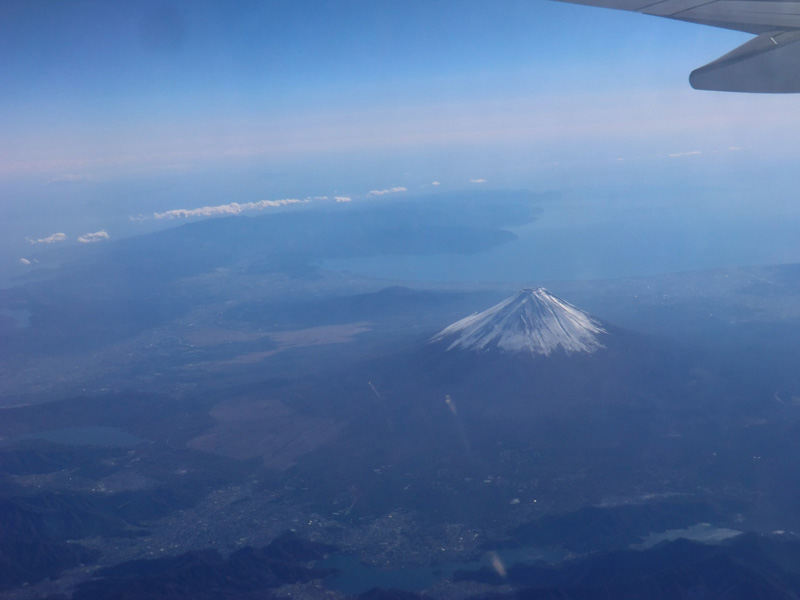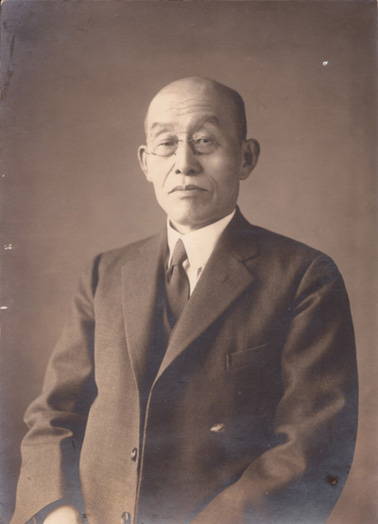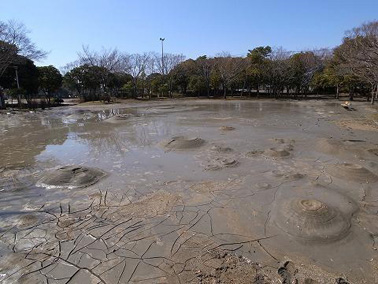
A photo I took out the window on a flight to South Korea to present my report "Earthquakes in Mythology." The Izu Peninsula is visible in the distance. The Izu Peninsula collided with the Eurasian Plate, "pushing up" Mt. Fuji. © Michihisa Hotate.
I love the essays of mathematician Kunihiko Kodaira and used to read them frequently at one time. I found the concept of "number sense" particularly compelling. It refers to the cognition that naturally develops in mathematicians' minds. I thought about an equivalent concept in historical science and came up with the term "time sense."

Takuji Ogawa
For a long time, historical science has forgotten the fact that Takuji Ogawa, the geologist who first pointed out the existence of earthquakes in mythology as an integral part of Japanese mythology, was also the father of Hideki Yukawa, a Japanese theoretical physicist and the first Japanese Nobel laureate.
Over the past two years, I have been researching the history of volcanoes and earthquakes. Now, a few months before my retirement in March (2013), when I will leave the Historiographical Institute, the fact that I feel the significance of the work of my predecessors, who collaborated in the historical earthquake research implemented by the Earthquake Research Institute, is probably an indication of some "time sense" with regard to my own life. Today, I am interested in the massive tsunami caused by a multi-segment earthquake in the Nankai Trough around 2,000 years ago. Kochi University Professor Makoto Okamura, who ascertained the scale of the tsunami through analysis of lacustrine deposits along the Nankai Trough, once said on TV, "In our work, we deal with long periods of time." From the perspective of one individual's lifespan, historical science, too, deals with overwhelmingly long periods of time, albeit not as long as the periods explored by geoscience. That is precisely what the concept "time sense" is all about. I have recently reached the conclusion that research which integrates humanities with science is necessary in order to further nurture such "time sense."
Incidentally, Japanese mythology was also formed 2000 years ago. There is a high probability that major earthquakes in that period may be recorded in some of the myths. In fact, according to the Kojiki ("Record of Ancient Matters"), which is the oldest extant chronicle in Japan and represents a collection of myths concerning the origin of the four home islands of Japan, when the Shinto god of the sea and storms, Susanoo, ascended Heaven in rage, "all the mountains and rivers shook, and every land and country quaked." In Greek mythology, too, the God of the Sea Poseidon is also referred to as the "Earth-Shaker" due to his role in causing earthquakes. Another point of significance is that the land, to which Susanoo was banished, was called "Ne-no-katasu-no-kuni," which is translated as "Hades," "Underworld," or the "Nether Distant Land." The use of the word "katasu" meaning "forge," however, suggests that there was a smithy in that land, and, furthermore, that there were gods of fire and smithery. These gods can be identified with Vulcan, the god of fire, including the fire of volcanoes, from ancient Roman mythology.

Liquefaction in Urayasu, Chiba, triggered by the Great East Japan Earthquake, which struck on March 11, 2011. The sand boiling has created miniature volcano-shaped formations that resemble Mt. Fuji. After the 1946 Tonankai Earthquake, too, people called these formations "Mt. Fuji." In my book Rekishi no naka no daichi dōran: Nara Heian no jishin to tennō [Earth's Convulsions in History: Earthquakes of the Nara and Heian Periods and the Emperor] (Iwanami Shinsho), I explain how people saw these formations as a manifestation of the gods of the Underworld. © Toru Sekiguchi, Faculty of Engineering, Chiba University.
Another popular legend tells the story of the young god Onamuchi (later known as Okuninushi), who visited the Underworld and fell in love with Susanoo's daughter. The couple stole Susanoo's "heavenly speaking-lute" and escaped, but "the heavenly speaking-lute brushed against a tree, and the earth resounded." This "heavenly speaking-lute" could be interpreted as a symbol of Susanoo's power to cause earthquakes. Onamuchi escaped from the Underworld through the crater of a volcano, and chasing him, Susanoo called out from the top of a hill: "With the great [treasures] which thou earnest, [...] become the Deity Master-of-the-Great-Land." The "na" in the name "Onamuchi" is interpreted to mean "land" as in the word "Ubusuna ("birthplace"), and signifies land as a part of nature. The fact that Onamuchi became "the Deity Master-of-the-Great-Land" ("Okuninushi" in Japanese) means that the god of nature became the master of the country. I think this myth is of a great significance to the people that inhabit the Japanese archipelago.
Recently, I am deeply concerned about the way many people indiscriminately and without reservation use the words "myth of safety" when talking about nuclear power stations. As a humanist, the use of the term "myth" with regard to something that can only be described as an "advertisement of safety" makes me extremely uncomfortable. It undermines the power myths have as ethnic heritage. I believe we must engage in a serious discussion about such perceptions in order to facilitate universities' efforts to respond adequately to social demands and advance full-fledged integration of humanities and science. After all, the time for which we must bear responsibility is virtually an eternity that stretches from the past, including the age of myths, to the future.




